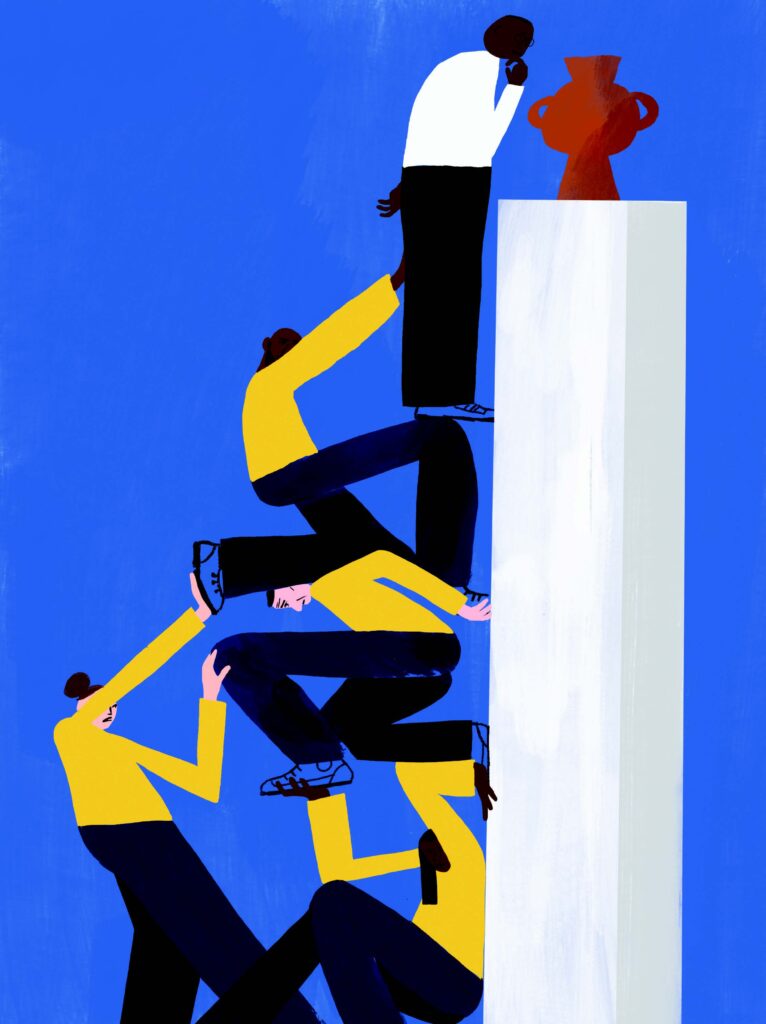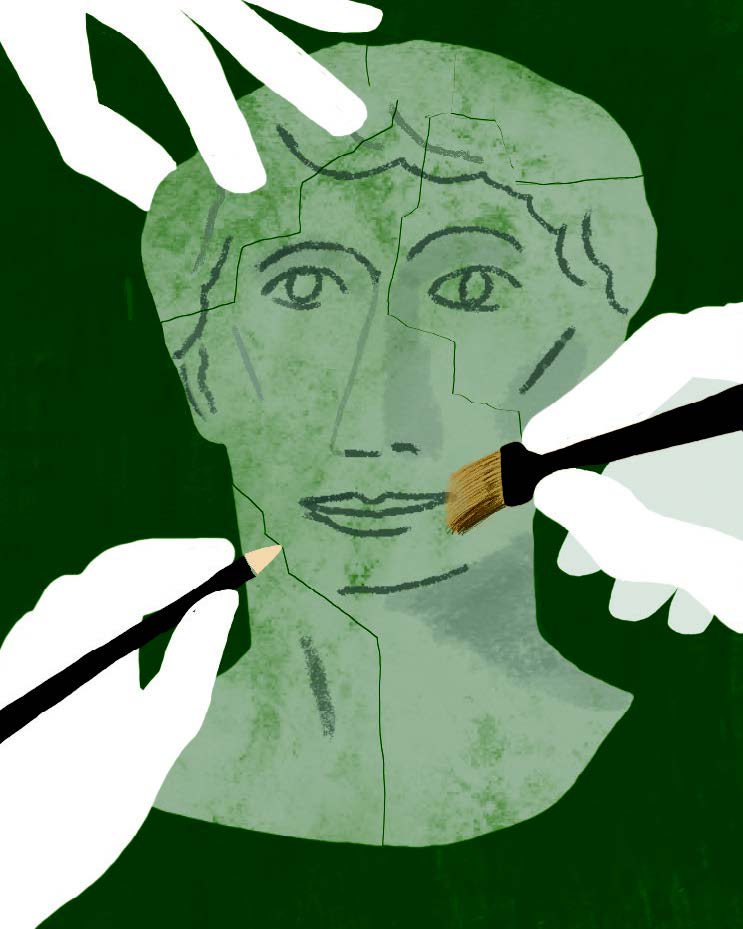Enjoy this article?
Most Museums Journal content is only available to members. Join the MA to get full access to the latest thinking and trends from across the sector, case studies and best practice advice.

In December 2022, a European Culture for Health report confirmed what is increasingly accepted in museums and beyond: culture is good for you.
Among other benefits, cultural activities can promote positive mental health and wellbeing, and “museums, libraries and other cultural venues can play a key role in enabling access to culture, and to a range of social health services”, says the report.
Museums in the UK are increasingly taking this to heart. As funding opens up in the area, many are introducing wellbeing activities and tools to community audiences. The sector-wide trend paints a hopeful, positive vision for museums as trusted centres of support, self-expression, and individual and community health.
But what of the workers who deliver these programmes and keep the institutions’ doors open; is museum culture good for them? Recent Museums Association (MA) research suggests it could be significantly better.
Defining wellbeing as being comfortable, healthy and happy, the 2022 survey of 658 sector workers found that while 71% had good life satisfaction, 58% had less good or low work satisfaction, with over a third rating it “significantly low”.
Respondents reported uneven levels of organisational support, and while most museums have some wellbeing interventions in place, there is clear need for more robust policies, practices and training within the sector.
Work to address this is already underway by the same teams that deliver museums’ public-facing wellbeing programmes, using their expertise to improve workplace practice. Community programmes engaging groups facing marginalisation, discrimination and trauma can take a heavy emotional toll on staff.
“The people who do this work are generally really empathetic,” says Victoria Ryves, until recently the manager of the History, Health and Happiness programme at Heritage Doncaster. “It’s tricky not to take some of that work home with you.”
During the pandemic, Ryves helped establish Glam (galleries, libraries, archives and museums) Cares, a peer support network for community engagement professionals. The group is still going strong and has been providing advice and help for the sector, including a recent online session run jointly with the MA that explored personal wellbeing.
Network members are embedding their learnings within their organisations. Kate Fellows, head of learning and access at Leeds Museums and Galleries, is writing trauma-informed practice into a workforce development plan and has enrolled key employees from the youth engagement and learning teams on in-depth training courses.

She is extending bitesize instruction to front-of-house staff, who are also likely to meet vulnerable members of the public, particularly as museums become prominent safe spaces.
“As our community programmes increased and we became more visible in the city, we found more and more safeguarding referrals walking through our doors of an increasingly severe nature.
The fallout on our staff was massive,” says Fellows. In addition to formal training, Fellows is setting up buddy systems and encouraging sharing to foster a culture of care among colleagues.
In Doncaster, Ryves developed her own support system for community and wellbeing staff that sat somewhere between reflective practice and clinical supervision.
Co-produced with the teams themselves, the programme includes a counsellor and an academic research team to ensure that interventions are professionally supported and evidence-based, but empowers staff to define what they need.
Such practices can help museums understand and articulate the boundaries of their community work; to know when to pause, change direction, or turn down projects, and crucially when to defer to specialist partners or refer staff for professional support.
“We’re basically applying the same principles to this as we apply to the sessions we deliver for the public,” Ryves says. “It comes full circle really. If we’re looking after ourselves, we’re looking after others better too.”
Of course, emotionally laden museum work is not restricted to community teams. Front-of-house staff handle challenging visitor needs, problems and complaints on a daily basis.
Decolonisation, anti-ableist work and other efforts to tackle institutional bias often fall to people with lived experience who are most likely to be emotionally and professionally affected. Individuals working with collections may find certain items – medical objects, for example – challenging or triggering depending on personal experience.
Social media officers can find themselves on the receiving end of online abuse. Every department has factors that cause stress, and museums would do well to extend the same culture of care and values of co-production, reflection and empathy, to them all.
One trap that museums can fall into when introducing workforce-wide wellbeing measures is genericism. Wellbeing challenges vary significantly by team, job role and individual, and broad-brush interventions – such as yoga classes or wellbeing apps – can only do so much, warns Tamsin Russell, workforce development lead at the MA.
“An organisation should have a battery of tools that they can use to support staff wellbeing and acknowledge that different individuals may require access to different things,” she says.
These tools need not be complicated or expensive. Simple changes to organisational processes can go a long way.
“You will risk-assess a workshop as to whether someone’s going to get a papercut, so you should build wellbeing into that risk assessment,” Ryves says. “Are staff going to be discussing contentious issues that could be challenging? Is there potential for safeguarding concerns?”
Fellows suggests that people should build contingency plans into challenging projects, so that staff members have the ability to step backwards from it if they need to.
More museums could benefit from employee assistance programmes and mental health first aid, which are available in 57% and 53% of organisations respectively according to the MA’s research.
Respondents also backed the introduction of wellbeing days; training for line managers, staff and volunteers; and the development of wellbeing policies.
Resources such as the MA’s Decolonising Museums guidance and Front-of-House Charter for Change, which both address wellbeing, are starting points that can be tailored to specific organisational needs.
Workers at Canterbury Museums and Galleries have been creating their own front-of-house charter, which will inform a wider staff wellbeing policy.
The organisation also monitors workforce wellbeing using the Warwick and Edinburgh Mental Wellbeing Scale. This builds wellbeing into organisational reporting, improving transparency and keeping the topic on the agenda.
Having proactive wellbeing measures in place can be especially helpful during periods of organisational change.
When Manchester Museum embarked on its Hello Future redevelopment project in 2019 (the museum reopened fully in February this year), it launched the Boost workplace wellbeing scheme alongside.
The programme offers a raft of activities and support – from yoga and cinema outings to art therapy and a welfare dog, Murray – and is shaped for and by the participants.
“Staff put forward ideas, and then we pick them up,” says Wendy Gallagher, the museum’s head of civic engagement and education. “All the ideas come from them.”
The museum also prioritised communication, holding regular all-staff meetings and surveys to ensure teams understood their roles, and introduced an internal newsletter to celebrate the contributions of all departments.
Gallagher recommends building wellbeing plans into all capital funding bids. “I think it can determine the success of a project,” she says.
These sorts of measures can help museums anticipate and mitigate emotionally challenging aspects of employees’ jobs. But there are other forces at work.
According to the MA’s research, the biggest factors impacting workforce wellbeing are chronic structural or cultural issues that consistently trouble the sector, including excessive demands, lack of recognition, not feeling valued, low pay, organisational culture and lack of progression.
Recent strikes at museums across the UK attest to the fact that many workers feel unsupported through the upheavals of the pandemic and the cost-of-living crisis. Unless wellbeing plans intersect with wider commitments to fair and positive working conditions, staff will still struggle.
“The recognition of precarity and wages as a wellbeing issue is not quite there yet in a lot of organisations,” says Louise McAward-White, co-founder of Fair Museum Jobs, which campaigns for better employment practices in the sector. “Meditating isn’t going to give you money for food.”
Fair work strategies, such as the one developed recently by Museums Galleries Scotland, are a sign that the sector is starting to look critically at working culture. But proper implementation is essential. One major factor hindering this is sector funding, which tends to prioritise project work (and thus short-term contracts) over longer-term organisational investment.
“If you aren’t funding core running costs for an organisation, you’re funding a lack of wellbeing,” says McAward-White. Building wellbeing into grant-makers’ requirements could help consolidate sector-wide change. “The arts council requires reporting commitments around workforce and pay gaps,” says McAward-White. “I would like to see that extended.”

Museums should also consider different types of employment and how these intersect with wellbeing efforts. Gareth Spencer, group president of the PCS Culture Group, points out that even where policies are in place, large chunks of the workforce tend to miss out.
“We have a lot of members who are outsourced into private security and cleaning firms,” he says. “Getting those people brought back in-house so that they can enjoy benefits [including] access to resources around mental health support would be really welcome.”
Wellbeing activities are often easier for office-based, weekday staff to attend, whereas front-of-house staff coming in on evenings and weekends don’t have as much ability to join. Freelance workers and volunteers also often miss out. Post-pandemic, the question of flexible working arrangements also looms large.
“Where individuals worked from home during the pandemic, they experienced a sense of greater autonomy,” says the MA’s Russell. But despite clear workforce interest in hybrid working patterns, many museums are saying no.
In Manchester, Gallagher’s team wrote its own hybrid working charter with encouragement from the University of Manchester. Letting people work from home where feasible has saved staff time and money. Gallagher also says it has “helped [them] to feel valued, to feel trusted, and [improved] work-life balance”.
Part-time and contract-based work, both of which are common in the sector, come with their own considerations. Part-time employees may be working multiple jobs or juggling other duties, making it difficult to cope with excessive workloads. Contract workers are expected to deliver high-impact, deadline-driven projects, while under pressure to find their next opportunity.
It’s important that managers are mindful of the pressures facing their teams. Many clearly are: it’s notable that respondents to the MA’s survey were most likely to report positive wellbeing at team level, and many attributed that to empathetic line managers. On the flipside, bullying is sector-wide.
“Museums and galleries are coming up with wellbeing plans and policies, but bullying is jarring to see when you’re a rep,” says Spencer of his union activities. “We deal with a lot of bullying across all workplaces [in our] personal casework.”
Supporting line managers in their duty of care is a concern for many and Russell suggests that organisations invest more thoughtfully in developing good management.
“We should recruit for people-oriented behaviours and train people to understand how they can support and manage the wellbeing of their teams,” she says.
“And the sector should adopt good performance management, with consequences for those who perpetuate bullying or otherwise problematic behaviour."
Ultimately, for workforce wellbeing to take root, it must be baked into a museum’s vision, mission and strategy, with buy-in from those in charge. But it also depends on the understanding, ideas, and actions of thousands of individuals throughout the workforce. Museum staff know their wellbeing needs; the first step for anyone wanting to make a difference is to listen.
“Genuinely ask your staff what would improve their wellbeing and do those things,” says McAward-White at Fair Museum Jobs. “[People] assume the solution has to be complicated. It doesn’t. But it is a conscious choice.”
The first step to cultivating a community of care is to start a conversation – to ask, and want to know, how things really are.
Maggie Gray is a freelance arts journalist
Most Museums Journal content is only available to members. Join the MA to get full access to the latest thinking and trends from across the sector, case studies and best practice advice.
You must be signed in to post a comment.
Low pay is a large contributor to this. The Museums Association salary guidelines, whilst a brilliant resource, have not been updated for two years, and many employers still reference this outdated guidance to set salaries for new posts at pre-inflation salary ranges. Please can this be prioritised by the policy team in 2024 if it is not being done already? This was done every year until around 2017.